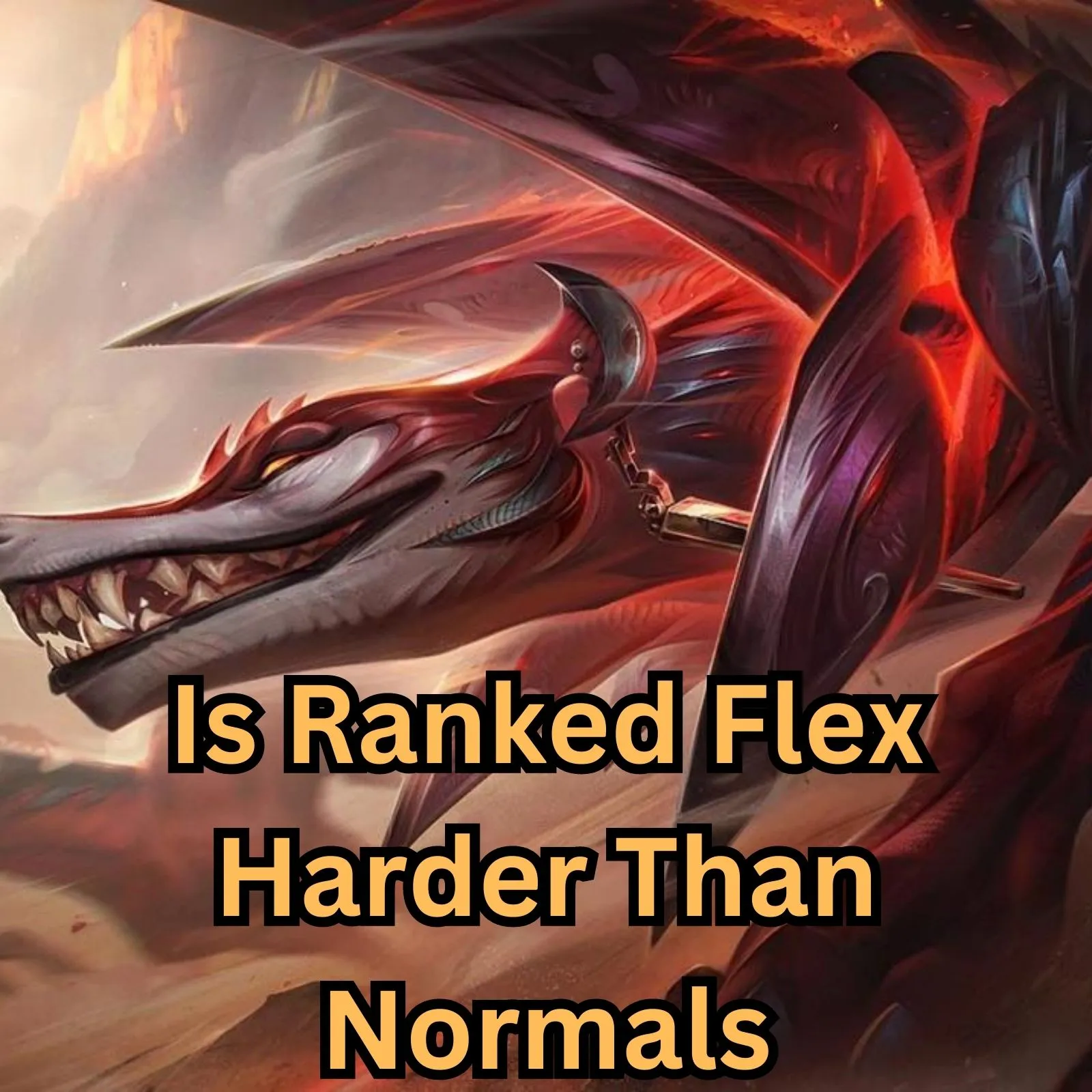
In the context of difficulty comparison, Ranked Flex generally presents a greater challenge than Normal games in League of Legends, due to its competitive nature and strategic complexity.
| Ranked Flex | Normals |
|---|---|
| Higher stakes, determined by league and division matchmaking rating. | Moderate stakes, but generally less intense due to absence of ranking score impact. |
| Usually consists of highly coordinated teams which can make games tougher. | Manages a mixed bag of individuals or small groups creating unpredictable matches. |
| Focused on serious play with strategic picks and bans. | Frequent experimentation with champs and builds, leading to unpredictable outcomes. |
| Punishment for leaving matches result in loss of League Points (LP). | Punishment for leaving doesn’t affect rank, but it influences your ‘Leaver Status’. |
The above table is a snapshot comparison of Ranked Flex and Normals in [League of Legends](https://na.leagueoflegends.com/en-us/). The major distinction between them lies in their competitive capacities.
Ranked Flex carries more weight, as it’s directly influenced by your matchmaking rating (MMR) which decides the player league and division. Players joining flex are usually more seasoned, playing tactically to earn higher rankings, making it harder than normals. Furthermore, ranked match coordination is comparatively superior, including pre-planned strategies, specific champion selections, and calculated moves.
On the other hand, Normals serve as less pressurized playground. While it’s still a competitive Zone, the absence of a concrete ranking system reduces the intensity of competition, thus making games more unpredictable yet less stressful.
Bjergsen, a legendary LoL esports athlete, once said, “_In Solo/Duo, you’re the only person you can rely on, but in Flex, it’s all about team play._” This quote underlines that Ranked Flex requires a higher level of seriousness and teamwork that translates into heightened difficulty compared to Normals.
Lastly, punishments also differentiate these modes. In Ranked Flex, leaving in-between can substantially harm your LP count, affecting your standings in the rankings, whereas forfeiting from a Normal game only contributes towards your ‘Leaver Status’. It’s clear that penalty-wise, flex can be harsher, contributing to its overall difficulty.
Overall, if one has to determine whether Ranked Flex is harder than Normals, the answer is yes — primarily attributed to the robust competition, strategic gameplay, and stronger penal consequences.The argument about League of Legends ranked flex versus normals is one that has been discussed extensively within the gaming community. When it comes to difficulty, it’s natural to ask “Is Ranked Flex harder than Normals?” Gaining clarity on this, can shine a light on your best strategy as a player, leading you down the path of most progress and enjoyment in the game.
Player Motivation & Mindset

A major contrast between ranked flex and normals is player motivation. In his YouTube video, League of Legends professional player Sneaky mentions the emotive difference between playing Ranked vs. Normal games. He points out that players in ranked games are generally more motivated to win, creating an atmosphere where everyone is playing their best champion with intense pressure. This is in comparison to normal games where players might be experimenting or just wanting to have fun rather than focusing purely on victory. Thereby implying that ranked flex might feel harder because of the prevalent competitive spirit.
| Differences | Ranked Flex | Normals |
|---|---|---|
| Player Motivation | High: Players focus on winning | Variable: Players may be experimenting or casual playing |
Team Composition & Strategies
Rank Flex queue allows you to queue up with multiple friends, this leads to increased synergy and communication amongst teams. These coordinated strategies can make ranked flex games significantly harder than normal games where you often play solo or perhaps with one other friend. Again, this aspect can elevate the challenge and complexity of the games making ranked flex seem tougher than normals.
| Team Aspects | Ranked Flex | Normals |
|---|---|---|
| Team Compositions | Potentially better coordination and synergy allowed by larger pre-made teams | Less control over team composition, mostly dependent on solo queuing players |
Elo/MMR matchmaking differences
League of Legends utilizes an Elo system, differing between normals and ranking games. Usually, ranked matches tend to have closer average MMR (Match Making Rating) between the two teams resulting in uniformly skilled opponents. In contrast, normal games sometimes showcase “mixed bag lobbies”, where you might encounter highly skilled and novice players in the same match. This randomness possibly makes normals unpredictable but doesn’t necessarily translate into them being harder compared to ranked flex.
Professional LoL player Bjergsen once said, “Every time unpredictability rises, so does the excitement.”
| Matchmaking Metrics | Ranked Flex | Normals |
|---|---|---|
| MMR distribution | Fairly uniformly balanced opposing teams | Potentially uneven skill distribution |
Therefore, whether flex rank feels harder than normals solely depends on myriad factors including your personal mindset, team composition, strategies, and matchmaking mechanics. If you relish challenging gameplay where teamwork is key and pushing yourself to the limits is standard protocol – ranked flex might indeed be heavier lifting compared to the lighter tone far from hardcore competences in normal games.
In the grand arena of League of Legends (LoL), players often ponder upon a pressing question. Is Ranked Flex harder than normals? Now this question doesn’t have a straightforward reply as it largely depends on varying factors such as team communication, individual skills and champion mastery.
Skill Level Assessment: The detailed analysis of skill levels in Ranked Flex versus Normals can be broken down by evaluating:
- Elo Difference: In Ranked Flex, you’ll find yourself pitted against opponents who are serious about climbing the ladder and often have higher Elo compared to normals, where the matchmaking is more casual.
- Team Communication: Ranked Flex demands solid teamwork. Flex teams coordinate their strategies diligently with an emphasis on objectives. On the contrary, each player in normals may follow their own agenda leading to lack of coordination.
- Champion Mastery: Players in Ranked Flex are likely to exploit their best champions strategically aiming for victory, whereas in normals, players practice new champions or even roles, resulting in variability of skill performances.
One must remember, however, that the inherent competitive nature of Ranked Flex does push players to improve at a faster rate than in normals due to its challenging environment. Faker, a renowned professional LoL player once said, “In order to be a successful player, you need the determination to improve.” And this enhancement in gameplay is certainly faster in the environment where every choice counts, aka Ranked Flex.
| Game Type | Key Differences |
|---|---|
| Ranked Flex | Competitive nature, higher Elo opponents, strong team communication, strategic champion usage |
| Normals | Casual matchmaking, variable individual objectives, versatile champion play |
In essence, the comparative difficulty between Ranked Flex and normals really boils down to the intensity of competition and the seriousness of players. If you’re looking for a challenge, seek improvement and value strategic gameplay, then yes, Ranked Flex can indeed appear to be harder than playing in normals.
When considering the question, “Is Ranked Flex harder than Normals?”, a multitude of factors come into play. The simple answer could be yes, however, it’s critical to explore the underlying complexities and distinctive elements posed by each mode to substantiate this claim.
The Matchmaking System

In Ranked Flex, you’ll encounter a more structured matchmaking system compared to that of Normals. Dota Esports discusses how this stringent model increases match difficulty as it aims to pair teams with similar skill levels, exacerbating hurdles for rookies or casual players.
| Ranked Flex | Normals |
|---|---|
| – Strict Matchmaking | – Random Matchmaking |
Strategy Implementation
Moreover, the degree of strategic planning in Ranked Flex is much higher, which brings additional challenges. To quote Lee “Faker” Sang-hyeok, a seasoned esports player, “League isn’t about outplaying your enemy, it’s about waiting for them to outplay themselves.” This mindset often prevails in Ranked Flex where strategic patience is as important as mechanical skills, which may not apply that much in a normals game.
Competitive Pressure
The level of competitiveness in Ranked Flex also adds up to its perceived difficulty. The pressure to maintain or improve one’s rank may indirectly increase the game’s hardness. In contrast, Normal games are relatively stress-free as there’s no ranking at stake – making them easier in comparison.
| Ranked Flex | Normals |
|---|---|
| – Competitive Stress | – Casual Play |
Team-based Coordination
In Ranked Flex, coordination among team members can either elevate or diminish the level of challenge. As a group-centered mode, poor coordination or communication could spell disaster. Conversely, Normals offers a mix of coordinated and solo plays, giving players more leeway to learn, experiment, and enjoy the match.
These comparative nuances affirm that Ranked Flex presents a more challenging environment, primarily due to its rigorous matchmaking, increased strategic demand, high competitive pressure, and team-centric dynamic. However, it’s imperative to remember that difficulty may vary among players due to their individual experience, skillset, and adaptability within the game.
“In solo queue, the only variable that matters is wins” – Yiliang “Doublelift” Peng. Doublelift has a point: your metrics of success in league games, particularly Ranked Flex or Normals, rests largely on your ability to emerge victorious. But there is often an ongoing debate among players about whether Ranked Flex is harder than Normals.
Assessing difficulty involves consideration of various factors like player behavior, strategy, and level of competitiveness involved in each mode. So let’s delve into some key differentiators:
Competitiveness

Ranked games by nature tend to be more competitive which can result in increased difficulty as compared to Normal games. This heightened intensity usually invites players to utilize more strategic methods and focuses on champion optimizations. As a result, Ranked Flex can seem much challenging for the unprepared player.
Team Cohesion
| Normals | Ranked Flex | |
|---|---|---|
| Team Composition | More random; less organized | Strategically selected; cohesive game play |
The table illustrates how team composition varies between Normals and Ranked Flex. In Normals, sometimes team members are randomly assigned which could result in less cohesive gameplay and strategy. But in contrast, Ranked Flex allows for premade teams hence promoting cooperation and tactic building which could heighten the obstacles faced during gameplay, hence making it seemingly “harder.”
Draft pick vs Blind pick
Normal games (especially blind pick mode) lack Element of Strategy compared to Ranked Games. In Blind Pick, you don’t get the opportunity to see the opponent’s picks and plan your champions around theirs. However, in Ranked Flex, matches are played through a draft system where players’ strategize based on their enemies’ selections which inherently increases the complexity of the games.
Player Behavior
Player behavior plays a pivotal role in determining a match’s ease or difficulty. Ranked Flex tends to attract players with more serious attitudes towards winning, hence amplifying the overall skill level within those games. More determined opponents quite simply mean tougher matches.
Though Ranked Flex might seem overwhelmingly harder at first glance, it doesn’t imply that it’s reserved only for the ‘elite’. With proper understanding of the game mechanics, champion capabilities, and effective communication within the team, you too can encounter success even in this mode’s rough terrains. Therefore, while I can agree that Ranked Flex presents elevated challenges compared to Normals, labeling one definitively “harder” than the other largely depends on individual player’s skillset, experience and adaptability.
When comparing the complexities of Ranked Flex and Normal games in League of Legends (LoL), it is crucial to understand their respective matchmaking algorithms. The fundamental disparity between these two game modes raises a fascinating question: Is Ranked Flex Harder Than Normals?
Matchmaking Algorithms
Ranked Flex implements a more meticulous algorithm, as opposed to the Normal mode. It takes into account players’ rankings significantly and strives for a fair match by pairing players with comparable skill levels together. High-Elo player Bjergsen once famously said, “Playing Ranked games is similar to climbing a ladder – every rung represents a new challenge.”
| Game Type | Matchmaking Basis |
|---|---|
| Ranked Flex | Players’ Rankings, Skill Level |
| Normal Games | Listed Preference, Hidden MMR |
On the other hand, the matchmaking algorithm of Normal games might seem less strenuous because it’s primarily reliant on your listed preference and hidden Match Making Rating (MMR). However, it doesn’t necessarily equate to less competitive or an easier gameplay experience.
Is Ranked Flex Harder Than Normals?

The answer to this intriguing question lies in each player’s perspective. For highly competitive players who thrive in challenging circumstances, Ranked Flex would be harder due to the following reasons:
- Increased focus on teamwork, since performing well as a team often decides the outcome of the game.
- Greater emphasis on strategic play, as superior tactics can tilt the game in your favor even when playing against individually skilled players.
- Matches generally last longer, requiring higher levels of concentration and endurance.
In contrast, if you’re a player who seeks fun-filled, stress-free gaming sessions, then Normal games might feel more difficult because:
- They include mixed-skill-level groups, which can lead to unpredictable gameplay experiences.
- You’ll encounter players experimenting with different champions and strategies, making the gameplay less predictable.
Ultimately, the difficulty of Ranked Flex versus Normal games depends on your individual playstyle preferences and your perspective towards the game. Whether you prefer the thrill of climbing up the ranks, or just enjoy playing for an entertaining casual time, both modes provide unique experiences catered to divergent gamers within the LoL community.
Remember, as LoL professional player Doublelift once said: “Everyone has a plan until they get punched in the mouth.” Be adaptable, embrace challenges in whichever mode you choose and most importantly, keep enjoying the game.
After a careful and in-depth analysis of both Ranked Flex and Normals in League of Legends, here are my thoughts on which one is harder. Judging by the different mechanics, gameplay styles, and level of competition, it’s clear that these two modes offer distinctly unique experiences.
Ranked Flex, while essentially still adhering to the classic LoL format, tends to pose more difficulty for some players. This can primarily be attributed to:
- The competitiveness and higher stakes – In Ranked Flex, each win, loss, or draw can impact your overall ranking. It puts you head-to-head with other focused and serious competitors.
- Increased Complexity – Because team coordination needs to be at an all-time high, a lot of extra communication is required. This means you’ll need to understand not just your own champion, but also be familiar with others’ abilities in order to combine effectively.
- Level of Opponents- Due to its competitive nature, this mode attracts experienced players looking to improve their rank and skills. So, those you’re matched against often have higher skill levels than average players.
On another note, Normals might seem easier to some because of several reasons like:
- Laid-back Environment: The casual setup allows players to experiment with new characters, strategies, and roles without the anxiety of losing ranks.
- Diverse Matchmaking: One might encounter both novices trying out LoL and veterans honing their skills. This diversity sometimes results in less balanced and thus, arguably easier matches.
Comparing these factors, it does seem that Ranked Flex commands a generally higher skill cap and requires more effort and strategic execution. As professional player Doublelift mentions, “In Flex five people are giving all they have to win…”, showing the heightened intensity and challenge involved compared to normals.
However, pinpointing exactly which one is ‘harder’ ultimately depends on an individual’s preference, their familiarity with gameplay mechanics, and their adaptability to changing game dynamics. Remember, at the end of the day, whether one plays Ranked Flex or Normals, continual efforts at learning and adapting will surely enhance your League of Legends experience.
| Normals | Ranked Flex | |
|---|---|---|
| Competition Level | Lower | Higher |
| Game Complexity | Dependent on match | Typically Higher due to teamwork |
| Player Skill Level | Ranges from Novice to Veteran | Generally Experienced |